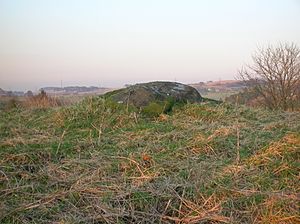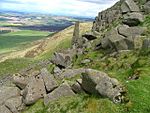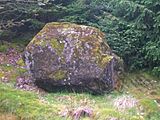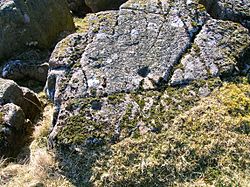Carlin stone facts for kids
A Carlin Stone or Carlin Stane is the name given to certain old standing stones and natural rock formations in Scotland. These stones are often linked to old stories about "hags" or "witches," especially the legend of the Cailleach, who is sometimes called the "Old Hag" or the "Goddess of Winter." The exact meaning of the name "Carlin" for these stones isn't fully clear, but it definitely connects them to ancient folklore.
Contents
- What Does "Carlin" Mean?
- Famous Carlin Stones in Scotland
- Carlin Skerry, Orkney
- Alvah's Carlin Cist, Aberdeenshire
- Backhill of Drachlaw Stone, Aberdeenshire
- Carlin Maggie on Bishop Hill, Perth and Kinross
- Balgair Muir's Carlin Stone, Stirlingshire
- Dunlop's Carlin Stone, North Ayrshire
- Carlin Crags, Darvel, East Ayrshire
- Waterside's Carlin Stone, East Ayrshire
- Carlin Knowe, Knockshinnoch, East Ayrshire
- Carlin Crags, Eaglesham, East Renfrewshire
- Carlins Cairn, Dumfries and Galloway
- Carlinwark, Castle Douglas, Dumfries and Galloway
- Carlin Stone, Wigtown, Dumfries and Galloway
- The Carlin's Tooth, Scottish Borders
- Carlin and Brigid
What Does "Carlin" Mean?
The word "Carlin" comes from an old Scots word. In Scots, a "Carle" was a common person or a husband. But "Carlin" was often used to describe an old woman in a not-so-nice way, meaning an "old hag."
This word comes from the Old Norse word Kerling. It's also similar to the Irish Gaelic word "Cailleach," which means a witch or the "Old Hag," who is seen as the Goddess of Winter.
"Carlin" is also a family name, with different spellings like Carlen or Carling. It's mostly from Ireland but is also found in Scotland.
Famous Carlin Stones in Scotland
Many places in Scotland have stones or natural features named "Carlin." These names often come from old stories and legends.
Carlin Skerry, Orkney
This is a small, rocky island located in the South of Orkney.
Alvah's Carlin Cist, Aberdeenshire
Near Sandlaw Farm in Alvah, there's a stone structure called the Carlin Cist. It's believed to have once been part of a larger ancient stone monument, like a Dolmen.
Backhill of Drachlaw Stone, Aberdeenshire
This Carlin Stone was part of a large stone circle, about 95 feet (29 meters) across. It's also known by other names like the Caerlin stone. Today, three stones remain in a line, with the Carlin Stone being much taller than the two next to it. People have found old tools and items like a small axe-hammer and parts of bronze bracelets near this circle.
Carlin Maggie on Bishop Hill, Perth and Kinross
This amazing natural rock formation is called Carlin Maggie. It looks like a giant statue, but it was formed naturally. Legend says it's a witch who was turned to stone by the Devil. The story goes that the Devil got annoyed with her and zapped her with a lightning bolt, turning her into this stone pillar. Carlin Maggie is about 30 feet (9 meters) tall and stands on the side of Bishop Hill, looking over Loch Leven.
Balgair Muir's Carlin Stone, Stirlingshire
An old map from the 1800s shows a "Carlin Stone" in this area, about 5 kilometers northwest of Fintry.
Dunlop's Carlin Stone, North Ayrshire
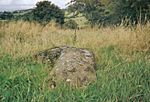
High up on the Common Crags, overlooking the village of Dunlop, is a large stone called the "Carlin’s Stone" or "Hag's Stone." It's a well-known local landmark. 55°42′47.9″N 4°31′20.6″W / 55.713306°N 4.522389°W
Carlin Crags, Darvel, East Ayrshire
Three farms near Darvel are named "Carlingcrags" on maps, pointing to more Carlin-related features in the area.
Waterside's Carlin Stone, East Ayrshire
Another Carlin Stone is found on Whitelee Moor, close to Craigends Farm in East Ayrshire. A nearby stream is even called the "Carlin Burn." In the past, many people visited this stone, as shown by the remains of a footbridge that once led to it. 55°39′34.6″N 4°20′59.7″W / 55.659611°N 4.349917°W
Carlin Knowe, Knockshinnoch, East Ayrshire
Carlin Knowe is a small hill with an ancient stone mound, called a cairn, at its top.
Carlin Crags, Eaglesham, East Renfrewshire
Near Bonnyton Golf Club in Eaglesham, there are rocks known as Carlin Crags. These rocks have special "cup marks" carved into them. These are small, round hollows made by people long ago.
Carlins Cairn, Dumfries and Galloway
This is the name of a mountain in the southwest part of Carsphairn parish.
Carlinwark, Castle Douglas, Dumfries and Galloway
The town of Castle Douglas was actually called Carlinwark until 1792. This name came from a nearby loch (lake) called Carlinwark Loch.
Carlin Stone, Wigtown, Dumfries and Galloway
A Carlin Stone can be found near Elrig Loch in Wigtown. It's thought to have been part of an ancient Stone circle.
The Carlin's Tooth, Scottish Borders
This is a natural rock formation in the Scottish Borders, located between Knocks Knowe and Carter Fell.
Carlin and Brigid
Near Stewarton, there are several farms named "Kilbride." The name "Bride" comes from Brigid, an ancient Celtic goddess. She was linked to the festival of Imbolc (February 1st), which celebrates the start of spring. Brigid was known as the goddess of healing and sacred wells. This makes her almost the opposite of the Carlin or Cailleach, who represents winter and old age.
Interestingly, old records show that the lands of Kilbride Cunninghame near Stewarton were also known as the "Lands of Carlin."


